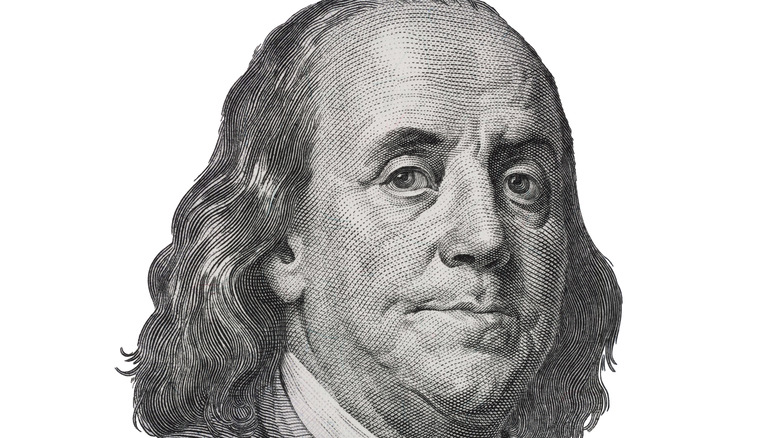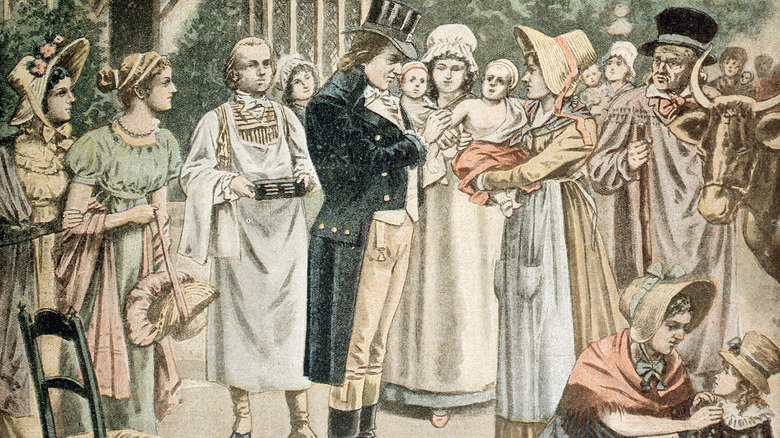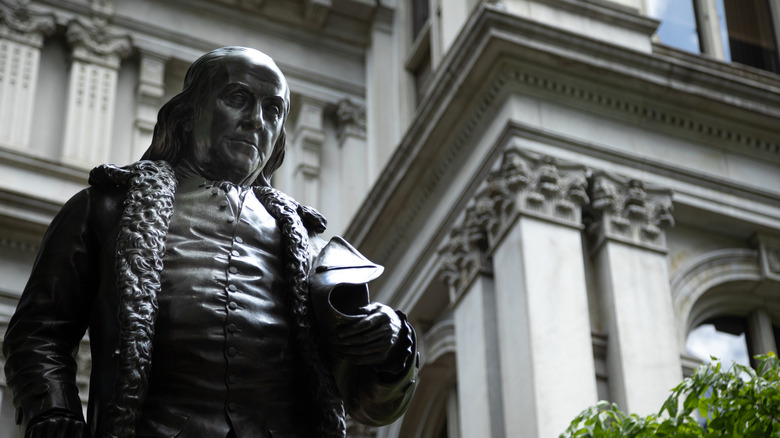The Tragic Reason Ben Franklin Regretted His Vaccination Decision
In the early 1700s, smallpox epidemics regularly plagued the planet (via NCBI). Dating as far back as ancient Egypt, some 3,000 years ago, smallpox scars have been identified on mummies (via the CDC). A highly contagious disease caused by the variola virus, smallpox initially causes a spike in body temperature, accompanied by body aches and vomiting (via the CDC). After the initial infection takes place, small red spots begin to break out on the tongue and in the mouth of the infected. It's at this point that the infected person is the most contagious. The rash eventually spreads to the rest of the body, with the small, red sores filling up with pus. The infection generally lasts about four weeks, with the pus filled sores scabbing over once the virus has run its course.
According to the AP, the HMS Seahorse docked in Boston, Massachusetts, in April 1721. Per Project Muse, the British passenger ship made its way to the colonies via a route through Haiti with a contingency of British soldiers on board. According to the New England Historical Society, a day after docking, one of the sailors presented himself with a full-blown case of smallpox.
Smallpox in the colonies
By June 1721, the disease was running rampant in Boston. With a population of about 11,000, an estimated 6,000 cases of smallpox had been reported within the city limits, with over 850 people dying from the infection, per AP. As news of the epidemic crossed the colonies, people began inoculating themselves against the disease. According to Science Museum, the practice of inoculation traveled to America in the 1700s by way of Asia. The process was simple enough: A healthy person would inhale a powder made from the scabs caused by smallpox. Another way to inoculate themselves was by sprinkling a little bit of smallpox powder over a scratch on the skin. While the person might still get sick, the symptoms would be much milder and an individual's immune system would become resistant to the disease.
On November 21, 1736, Ben Franklin's 4-year-old son, Francis Folger Franklin, died from complications from smallpox (via History of Vaccines). Since Franklin was such a staunch supporter of inoculation, the public actually believed that Francis Franklin's death occurred from the inoculation, and Franklin was just trying to cover it up. Unfortunately, the truth is quite the opposite.
Ben Franklin's painful loss
Benjamin Franklin never had Francis Franklin inoculated. According to Stars and Stripes, Franklin took to the Pennsylvania Gazette in December 1736 to explain the situation. Francis had been suffering from a bad case of diarrhea. Franklin's intention was to inoculate the boy after he recovered, but sadly, that never came to be.
"In 1736 I lost one of my Sons, a fine Boy of 4 Years old, taken by the Smallpox in the common way," Franklin later said about the whole situation, per History of Vaccines. "I long regretted that I had not given it to him by Inoculation, which I mention for the Sake of Parents, who omit that Operation on the Supposition that they should never forgive themselves if a Child died under it; my Example showing that the Regret may be the same either way, and that therefore the safer should be chosen."


